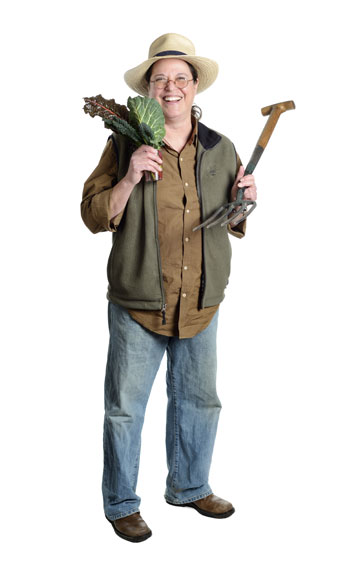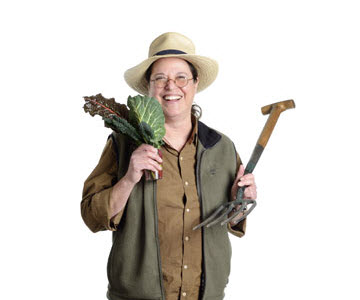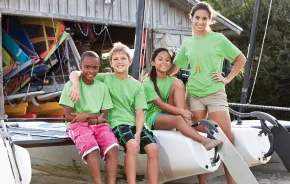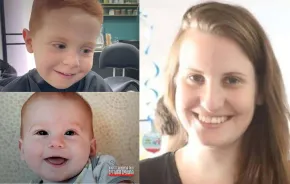 Lisa Taylor is the children’s education program manager at Seattle Tilth, an educational organization that teaches us ways to grow food organically, conserve natural resources and support our local food systems. When she is not growing and eating plants with children, Taylor, author of Your Farm in the City: An Urban Dweller’s Guide to Growing Food and Raising Animals, is a frequent speaker on soils, compost and children’s gardening.
Lisa Taylor is the children’s education program manager at Seattle Tilth, an educational organization that teaches us ways to grow food organically, conserve natural resources and support our local food systems. When she is not growing and eating plants with children, Taylor, author of Your Farm in the City: An Urban Dweller’s Guide to Growing Food and Raising Animals, is a frequent speaker on soils, compost and children’s gardening.
Why are you so passionate about getting children into gardens?
Gardens do a number of things for children. First, they connect them with nature. When I was a kid, we stayed out and played until the streetlights came on. I took that for granted — I thought that was what childhood was all about. But in the city, that’s not what we do. We don’t let our kids loose to explore.
Nature is right here; it’s all around you. In a lot of ways, backyards, parks and public gardens are an easy connection to nature for all people who live in a city. Those who are lucky have a garden of their own; they can let their kids go explore, maybe while watching them through the kitchen window.
Then, there’s the science. What’s so cool about an organic vegetable garden is that it’s a little ecosystem. The bugs, the soil, the plants — you can learn so much about how things grow in that teeming, wonderful ecosystem of an organic garden. It’s the whole world right there in a little square of your back yard.
For me, the whole point of gardening together is to learn how to care for other living things and for ourselves.
Caring for home, friendship, observation, biodiversity, and other key themes around peaceful interaction happen naturally when a group of people are working together on a project. And because a garden is a living thing, you have to have extra care and extra teamwork … it’s an excellent vehicle for practicing all of these things. I think that teaching children to garden is one of the ways that we can save the world.
You also talk about another motivation of gardening: eating.
Yes, on a practical level, learning how to grow your own food and feed yourself is a great skill to have and to learn. Eating well, knowing about food and knowing where it came from is getting so lost these days, because so much food comes in boxes.
Research shows that kids who have a hand in growing, cooking and preparing food will try it. They may not like it, but they will try it. And they’ll be excited about it in much different way than they get excited about macaroni and cheese.
What’s your approach to teaching children to garden?
We ask the question: What absolutely has to be done by an adult? Maybe lifting heavy things, driving the car to get supplies or tying the knots in the strings on the trellis. The children do the rest. For, by and with children — that describes our children’s gardens.
There’s a great amount of capability that’s learned in a garden. The children think, “I’m capable, I’m constructing things, I’m making things.” I think that a lot of children I see just don’t do things for themselves. They aren’t picking up their backpacks; it gets done for them. It’s hard to have a lot of confidence and self-esteem if you’re not actually doing these capable things.
Working in a garden provides that.
How early can you start kids gardening?
As soon as they’re ambling. Sometimes pre-ambling. Sometimes pre-this world! We’re even educating in utero.
How should parents go about getting very little ones started?
When they’re babies, let them toddle around and play in the mud. Share your love of gardening with them — that’s what gardening looks like, at first.
As they get older, they’ll start to do more. When they become even older, they might still garden, but often not with you, sadly. But they’ll garden with other people; that’s why you send them to garden camp!
But no matter how old they are, have them be outside with you. If you can get them to plant a couple of things with you before they peel off, that’s good; that’s what gardening looks like with older kids. Just refrain from using the words “yard work.”
“Hey kids! Come outside and do some yard work!” It’s not going to get them interested.
When my son was younger, he’d come out and help me garden, but mostly he’d be building bug houses the whole time. As he grew, his abilities to interact with my level of gardening changed. He was interested in my propagation area for a while. What I’ve noticed now that he’s 13 is that he’s expressing his own interest in the growing world. He’s really into bonsai, carnivorous plants, succulents ... things that I know nothing about. It’s great that he can learn on his own and share with others.
How did you get involved with Seattle Tilth?
I went to the University of Oregon, became a high school teacher in southern Oregon, then went to graduate school at Western Washington University. I taught all kinds of art classes, children’s theater — I’ve been a teacher for almost 30 years — and then I got hooked on composting and recycling. I became a master composter through the program that Seattle Tilth runs.
In 1995, I started working for Tilth, answering the compost hotline. In 1998, I got a job in the children’s garden; I’ve been at it ever since.
How many kids do Seattle Tilth’s children’s programs serve?
In our Good Shepherd gardens alone we served 5,300 children last year, in summer camps, garden tours, field trips, in-classroom programs and after-school programs at school gardens, but we have programs all over the place, from the Pickering Barn in Issaquah, to learning gardens at South Shore School in Rainier Beach.
We interact with a lot of children and families, and they all hold worms and eat plants they never thought were edible. The groups and the camps that come to the garden actually do the work that happens in the garden, so our job is a complex puzzle every day, trying to figure out what needs to happen in the garden, what groups are coming, and what they can do to advance the garden.
What makes a children’s garden different from other gardens?
In a children’s garden, the plants should mostly be edible, because the kids are still learning and you need to make sure it’s safe. In my book, when I talk about laying out a garden, I start with the question, “Where are your feet?”
The first rule of the garden: Plants and people can’t go in the same place. If you have children and you make your paths only three feet wide, you’re going to be yelling at your kids all the time to stay out of the beds. Instead, make the beds narrow and the paths wide, so the kids can jump over the beds. Because children will jump over beds! As an organic gardener, I work with nature, and the nature of children is that they jump.
Earth day was founded in 1970, and Seattle Tilth just a few years later. Do you celebrate Earth Day at Seattle Tilth?
Earth day is every single day. I think Earth Day is awesome, but I’ve never really done anything special to celebrate, and we don’t do anything special at the garden that day . . . we just do these things every day. We don’t take just one day to thank the earth for everything it gives us and teaches us.
Do you have a suggestion for parents who want to do something special with their kids to honor Earth Day on April 22?
Plant culinary herbs — a rosemary bush or sage or thyme, and then use it in the kitchen to cook a special Earth Day pizza together. Earth Day comes a little early for putting things into the ground around here; usually the first week of May is best. Our May Edible Plant Sale (May 4–5, 9 a.m.–3 p.m; Meridian Park, 4649 Sunnyside Ave. N., Seattle; free) usually signals that it’s warm enough to put stuff into the ground.
Who is your personal hero?
One of my heroes as far as educating children is Ella Jenkins. My heroes around teaching peace are Pete Seeger and Dan Zanes, who is the modern-day Pete Seeger.
For gardening, my heroes are the fathers and the mother of the organic movement. Rudolf Steiner (who founded the biodynamic farming movement) and Lady Eve Balfour and Sir Albert Howard, and Alan Chadwick who really brought what we do. Recently, the permaculture pioneer Bill Mollison; his spirit and his work has really influenced me and what I am trying to do. I am trying to further their work. I want to be like them.
What really empowers me when I read about these people is that, regardless of what their particulars are, they all connect the health of the environment with the health of the individual--not just physical, but spiritual, mental and intellectual health, as well. They all had a reverence for the health of the soil and the interconnectedness with the health of the people.










